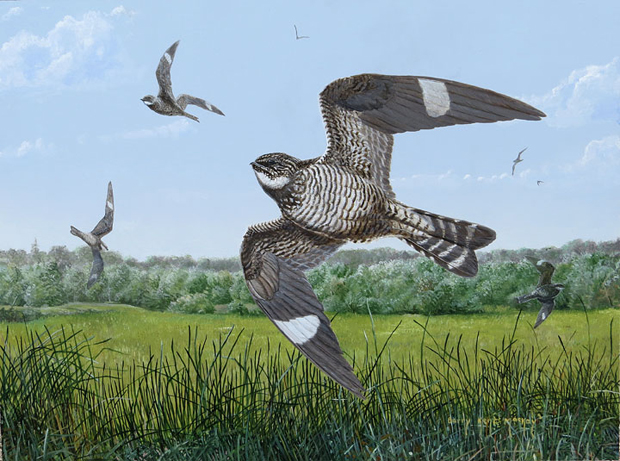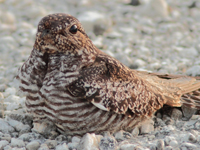

Join BirdNote tomorrow, November 30th!
Illustrator David Sibley and actor H. Jon Benjamin will face off in the bird illustration battle of the century during BirdNote's Year-end Celebration and Auction!
Common Nighthawk... Not a hawk, and not all that common, either!
The Common Nighthawk is not, of course, a hawk, but belongs instead to the family Caprimulgidae. This includes Whip-poor-wills, Common Poorwills, Chuck-will’s-widows, and a wide variety of other species, all known as nightjars. They all have small beaks, large eyes, tiny feet, and soft plumage, and they all feature extremely cryptic colour patterns in various shades of brown, rust, tan, and grey, often with bold white wing and tail markings. A few species have extremely ornate individual wing feathers.

Nightjars have very large mouths. Many (although not this Common Nighthawk) have well-developed rictal bristles (hair-like feathers around the mouth). They are often most active at dusk or at night, when they feed on flying insects. They tend to have distinctive voices, in some cases quite melodic, others less so. At least one species -- Common Poorwills -- can hibernate, while others are migratory, and still others remain in their respective environments year round.
The Common Nighthawk has a huge range, being found breeding throughout most of temperate Canada, and much of the eastern and midwestern US, as well as through Central America to southern Panama. The species is quite migratory, wintering in much of South America east of the crest of the Andes. It can be seen on migration in Bermuda and the West Indies and is a strong flyer, with long, pointed wings.
Common Nighthawks nest on gravel and bare ground or on leaf or pine-needle litter or sand, and usually lay two eggs. They have adapted to nesting on flat gravel rooftops in my region of Ontario. The down-side of that is that the Ring-billed Gull (Larus delawarensis) has, in recent decades, learned to nest on flat rooftops as well, and they eat the eggs and young of other species. This may account somewhat for a decline in numbers of Common Nighthawks, at least in my region. Other culprits could be the decrease in large insects and the dearth of those flat-topped roofs.
When I was young, we used to see huge flocks flying over the city streets – they were easy to see because they would call with a very distinctive, nasal call. I rarely see such flocks these days.
The painting was done in acrylics on Masonite panel.
###
Barry Kent MacKay lives and works in Ontario, Canada.Learn more

Listen to a BirdNote show about the Common Nighthawk:
Common Nighthawk, Uncommon Sound

